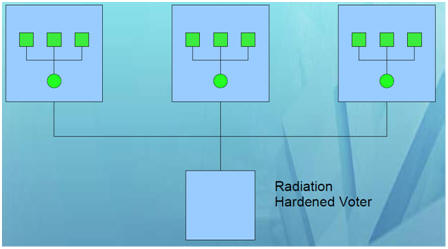Reliability
A key concern for a several hundred year long mission is reliability. For this mission, system reliability is improved through redundant systems and radiation hardening of the electronics.
Radiation hardening of electronics is important for any space-based system. On Earth, the Van Allen belts protect us from the protons, electrons, heavy ions, alpha particles, and cosmic rays that are emitted from the Sun and other stars. These stray particles cause distrubances in digital electronics. A single event upset is a bit flip in the digital circuit due to the stray particle. A single event latch-up is high current due to the precence of heavy ions. Total Ionizing Dose (TID) is a measure of the acculmulation of charge on a transitor's oxide layer. After enough charge,the transistor's threshold voltage can change.
Single event upsets can be mitigated through techniques like Triple mode redundancy (TMR). The logic is triplicated and a voting circuit picks the response with the most "votes". TMR can be used in all the spacecraft's electronics to improve reliablity.

The only way to mitigate TID is to use a radiation hardened process, such as Silicon on Sapphire. TID will be a concern for this mission because of the long duration. Shieldingn may be required to protect the electronics, at the cost of adding weight to the payload.
The commmunication system is built for reliability: several of the TWTAs can fail, but the system can adapt with spares and or by dropping the data rate. This is an example of cold-swapping, another reliability technique.
However, the one weakness in the communication system is the inflatable antenna. Astroid belts and other debris could potentially tear a hole in the thin antenna material. Unfortunately, even though the antenna is "light" per square foot, the total mass is very heavy and a spare antenna was not considered.
